Ann Arbor sustainability series kicks off with discussion of urban forest, recycling and Huron River
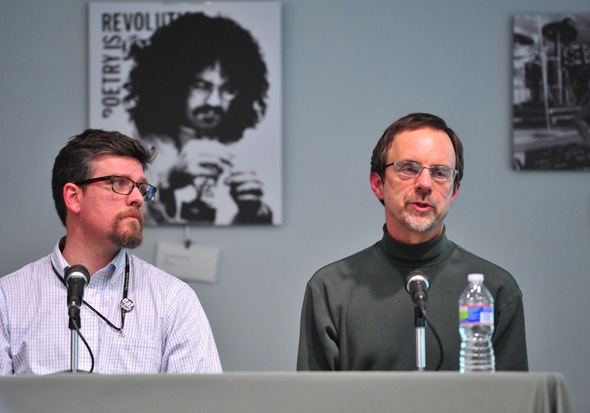
Jason Tallant of the city of Ann Arbor's Natural Area Preservation program, left, and Tom McMurtrie, the city's solid waste coordinator, appear on stage Thursday night during the Sustainable Ann Arbor discussion series at the Ann Arbor District Library.
Ryan J. Stanton | AnnArbor.com
"There probably are a handful of other cities across the country that are doing things as fabulously as we are, but not very many," said Chris Graham, chairman of the city's Environmental Commission and one of the featured speakers Thursday night.
More than 80 people were in attendance at the Ann Arbor District Library for the first of four forums being held as part of the Sustainable Ann Arbor discussion series.
"I am pleasantly surprised at our audience tonight," Matt Naud, the city's environmental coordinator, remarked at the start of the event.
In addition to Naud and Graham, five other local leaders took turns speaking. That included Richard Norton, an urban planning professor at the University of Michigan; Laura Rubin, executive director of the Huron River Watershed Council; Tom McMurtrie, the city's solid waste coordinator; Kerry Gray, the city's urban forestry and natural resources planner; and Jason Tallant of the city's Natural Area Preservation program.
The sustainability series is organized around four theme areas. Thursday's forum focused on the topic of resource management.
Land use will be the topic of the next forum on Feb. 9, followed by climate and energy on March 8, and concluding with a broad discussion about community on April 12.
"Sustainability is bigger than just the environment," Norton stressed. "The environment is a fundamental, vital piece of it. It's not all there is."
Managing Ann Arbor's urban forest
Gray talked about her role in helping the city manage an urban forest that contains literally tens of thousands of trees, earning the city its "Tree Town" nickname.
"It's a tremendous asset within the city, and it's something that we really need to be managing," she said. "And in the past, we haven't had a management plan for the city for our urban forest, and so in 2010 we began our plan development."
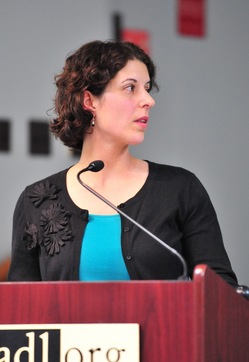
Kerry Gray, the city's urban forestry and natural resources planner, said there are public meetings coming up as part of the development of the city's urban forest management plan.
Ryan J. Stanton | AnnArbor.com
The city has taken inventory of its leafy assets and found it manages 42,776 street trees and 6,923 park trees in mowed areas, and has 7,269 potential street tree planting sites, Gray said.
In recent years, the city has planted thousands of trees along streets and in parks to replace both ash trees lost to the emerald ash borer and other trees that died or were removed.
Naud recalled 10,000 of the ash trees managed by the city were lost to emerald ash borer, in addition to others in the city, including two on his property.
"We don't know what that next critter is that's going to come in and take away part of our forest," he said. "It was over $2 million we spent just on the safety of getting down the EAB ash trees that we took down, let alone what residents paid."
In 2010, Gray said, the city completed a canopy analysis — essentially looking at the city from above and using aerial photography to identify how much tree canopy covers the city.
That analysis showed citywide there was 32.9 percent canopy, Gray said, and about 46 percent of that was in residential areas, while 23.7 percent was in the public right-of-way — essentially the area between the sidewalk and the curb. About 22 percent was in recreation areas.
In terms of diversity, 37 percent of the trees in the city's inventory are maple, while the second most common kind is honeylocust (8 percent), followed by oak (7 percent). The rest are a mix of crabapple, spruce, pine, elm, pear, sycamore, linden and others.
"When we're doing our tree planting now, in terms of the city, we are really are not planting any maple," Gray said. "And then we also discourage that (with residents and developers). So when we have commercial development come in for a site plan, if they're proposing maple, we try to discourage them from using that and try to think about diversity."
Protecting natural areas
Tallant gave a broad overview of the work NAP is doing to protect and restore Ann Arbor's natural areas and to foster an environmental ethic among its citizens.
"We sort of straddle that line between services provided to people and sort of empowering or teaching others to do things in the parks system and on their own lands," he said.
He talked about what it means to facilitate restoration.
"We do detailed botanical inventories of all the plants that occur in city-owned natural areas," he said. "We also do detailed inventories of the other critters that live out there, and so we have an idea of what's occurring in the landscape and what's using the landscape, and that's important for sort of thinking about ecosystem services."
NAP also does invasive species control.
"So when you see someone walking down the street with a big orange bag on their back, full of garlic mustard, it's because they are putting an effort into restoring or helping the land in a way that doesn't further diminish the biodiversity of that landscape," he said.
The Huron River watershed
Rubin talked about the role her agency plays in stewardship of one of the area's most prized assets: the Huron River watershed.
"We were originally formed by units of government to care about and protect water, a local resource," she said. "And what happened was, in 1965, 17 units of government came together and said, 'Who care's about this shared resource beyond our political boundaries?'"
Rubin noted the Huron is the only river in Southeast Michigan that has the state's "Natural Rivers" designation.
"It affords the Huron some very special protection in terms of vegetative setbacks and building setbacks," she said. "By having had a lot of focus on the watershed and very progressive communities, we have some very strong local and regional regulations."
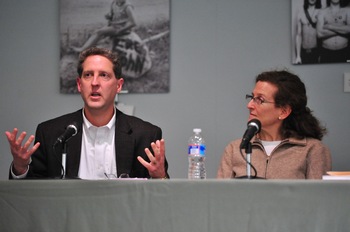
Richard Norton, left, talks as Laura Rubin listens during Thursday's forum.
Ryan J. Stanton | AnnArbor.com
"We especially think of it in terms of drinking water because we get 85 percent of our drinking water from the Huron River," she said. "But some of the other things that I think are more intangible are property values, wildlife habitat, stormwater control and recreation."
But the river also has its share of problems.
"In the Huron, one of our largest problems is excess phosphorus — nutrients that are coming off the landscape, exposed soils, our lawns," Rubin said. "We also have problems with E. coli, especially in our urban areas, after heavy rain events."
That's coming from a lot of animal feces, Rubin said, but also sometimes human waste with illicit connections — pipes that should be going to the wastewater treatment plant that are hooked up to the stormwater system.
"We have very erratic flows," she added. "We do get low dissolved oxygen. We have, as many lakes in Michigan do, mercury problems, which are atmospheric mercury deposition. And we also have sort of historic contamination, especially with PCBs."
Rubin said some of those problems are due to the loss of natural areas as Ann Arbor has grown into an urban city.
"We've lost a lot of the natural green infrastructure and natural areas — the wetlands, floodplains," she said.
She said there are 97 known dams and probably another 50 that are unknown throughout the watershed, and that changes the flow patterns tremendously.
"Similarly, non-point source pollution adds to those erratic flows," she said. "Non-point source pollution is really what you see, especially if you walk out today, and you look at where the rain is falling on the rooftops, to the gutters, on the roads, and going into our storm drains. It's warmer water. It's carrying a lot of pollutants directly to the river."
But up and down the watershed, from Oakland County to Livingston, Washtenaw and Wayne, there are many stakeholders working to protect the watershed, Rubin said.
"We have very good data sets," she said. "The Huron is the best-studied river in Michigan. We have been studying this river for a very long time."
Rubin said the Watershed Council and its partners have a great capacity to educate and advocate for policies.
"We push people to do more to protect the river," she said. "A lot of times we're bringing the data to the table."
Rubin mentioned the group's water quality monitoring and adopt-a-stream program as ways it is promoting stewardship of the watershed.
"The value of having these eyes on the river is we're tracking the long-term trends," she said. "We have a scientific basis for a lot of the local and statewide policies."
Recycling and composting
"Ann Arbor has the distinction of being one of the top recycling communities in the U.S., according to a recent EPA study," McMurtrie said.
McMurtrie talked about what the city has done to make recycling work in Ann Arbor. In the 1970s, he said, curbside recycling was brought to every single-family home in the city.
"At that time, we had to separate green glass from brown glass from clear glass from newspapers from cardboard," he said, adding it reminded him of an old New Yorker cartoon titled "Recycling In Hell" where recyclables were tediously sorted into countless bins.
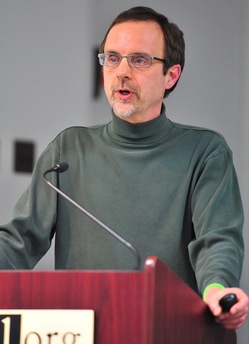
McMurtrie stressed the importance of recycling. But even more important, he said, are the two other Rs: reducing and reusing.
Ryan J. Stanton | AnnArbor.com
At that time, every multi-family household in Ann Arbor was added to the program, which doubled the number of residents participating, McMurtrie said. The city saw a large increase in recycling after that.
"We built a sorting facility at the location of what is now the drop-off station on Ellsworth Road," McMurtrie said. "We had this sorting container line added, which was actually built by a manufacturer that built potato-sorting equipment, and this thing was able to sort each color of glass and the metals and the plastics. … We added the HDPE plastics at that time, which was a big move."
In 2010, the city moved to a whole new level with the introduction of single-stream recycling where all recyclables now go into one cart, McMurtrie said.
"A number of new types of plastics were added to the mix," he said. "Every household in Ann Arbor received a cart as part of this program with a radio frequency tag in it that allowed them to participate — at least the single-family households — in a program called RecycleBank, where you could get points for putting your cart out with the recyclables each week."
The city also completed a $3.5 million overhaul of the Materials Recovery Facility on Platt Road in 2010 and city tonnages to the MRF went up 25 percent, McMurtrie said. Overall tonnages to the facility tripled with materials coming from as far away as Toledo and Lansing.
"The city, which owns the MRF, was able to collect money from each one of those tons that came to the facility," McMurtrie said. "So this contributed to a much quicker payback on this investment than we originally anticipated."
Four new hybrid automated recycling trucks were purchased for the program, McMurtrie said, noting they use significantly less fuel. He said four more are being purchased in 2012.
McMurtrie stressed the importance of recycling. But even more important, he said, are the two other Rs: reducing and reusing.
"Reducing the amount of stuff you use is one of the most effective things you can do to make your life more sustainable," he said. "You can buy fresh produce with less packaging. You can shop your local farmer's market to, again, reduce the amount of packaging you purchase."
When you do need to buy something that comes in a package, McMurtrie said, it's important to reuse or recycle it afterward.
"As an example, making aluminum cans from old ones uses one-twelfth of the energy," he said. "Similarly, with plastic bags, making them from recycled polyethylene takes one-third of the sulfur dioxide and half the nitrous oxide than making them from scratch."
Composting is another sustainable management practice for solid waste, McMurtrie said. Every pound of yard waste or food waste that residents can compost reduces the burden on landfills, he said, noting it's now an option to put food waste in yard waste carts in Ann Arbor.
"More and more people are using it for their food scraps," he said.
McMurtrie said the city is starting to work on a solid waste management plan, which he expects to be about a six-month process.
"And we encourage the public to participate in this," he said.
Audience feedback
A handful of residents offered their feedback Thursday night. One complaint was that the city's residential curbside compost collection program runs only from April through mid-December.
Another resident asked how the city might add incentives to get residents to reduce consumption and trash going to landfills if that's really the goal.
"The simplest way would be to do a graduated fee system on our trash production, to charge more for larger trash containers," McMurtrie responded. "We are doing that to some extent now. People who have 96-gallon trash carts pay a fee each year for the option of having that trash cart. People who have 64- or 32- gallon trash carts do not pay a fee."
He said the fee for the larger trash cart is about $35 per year.
"So possibly we might want to look at incentivizing that a little more to encourage people to produce less waste," he said.
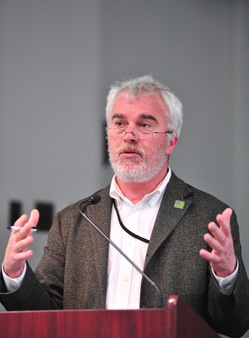
"The Home Depot Foundation was generous to give us about $100,000 to work on a larger sustainability framework project," Naud said. "And that's funded some staff that have helped organize this, so I'd like to thank them."
Ryan J. Stanton | AnnArbor.com
"That's an option to look at," he said. "I know that council's been a little hesitant to do that in the past because that becomes a regressive tax for lower-income people with large families, so it gets a little sensitive in those ways."
Another resident asked why the city doesn't accept No. 3 plastics or so-called biodegradable plastics in the recycling stream. McMurtrie said it's because they're contaminants.
"No. 3 plastic is polyvinyl chloride, which is a very significant contaminant if it gets mixed in with other plastics," he said. "So it's unfortunate that we weren't able to say in the new program 'just any sort of plastics,' but we wanted to be responsible and not include this material."
As for so-called biodegradable plastics, McMurtrie said that's been a challenging issue to deal with. On the surface, he said, biodegradable plastic sounds like a good idea.
"It'd be nice to add, in some ways, to the compost waste stream. But there's a couple issues with that," he said. "All the research that we've read about compostable plastics, biodegradable plastics, is that they break down into very small particulates that are not necessarily good for the environment. There's still a petroleum base to most of these."
Questions about expanding the items that will be accepted in the city's compost and recycling streams will be explored as part of the solid waste management plan, McMurtrie said.
Ann Larimore, a longtime Ann Arbor resident, asked about the proposed Fuller Road Station project, which includes a parking garage with nearly 1,000 spaces in the first phase.
"Bringing 1,000 cars into Fuller Road, just opposite the Fuller Pool and in a park area — having them go into a parking structure twice a day, and exit a parking structure twice a day — seems to me to very adversely affect the air quality along that corridor," she said.
Naud said he didn't know whether a formal air quality study has been done yet but he's going to look into the issue.
Earlier in the meeting, Norton said a lot of local officials are reticent to step out and undertake proactive environmental initiatives because they're concerned it isn't their role or budgets are tight, but he thinks Ann Arbor breaks the mold.
"I think Ann Arbor is stepping out in front of a lot of communities," he said. "I think with the things that we're doing here, we're kind of pushing those boundaries and that's great."
Ryan J. Stanton covers government and politics for AnnArbor.com. Reach him at ryanstanton@annarbor.com or 734-623-2529. You also can follow him on Twitter or subscribe to AnnArbor.com's email newsletters.


Comments
roadsidedinerlover
Sat, Jan 14, 2012 : 12:14 a.m.
I REALLY wish the city council and the mayor would start up the discussion about banning plastic bags. I work for a major retailer and you would not believe the amount of plastic bags I give out in one day. We promote re-usable bags and reward our customers if they use their own bags. I still give the plastic bags out. We really need to ban them now!
whatsupwithMI
Sat, Jan 14, 2012 : 2:03 a.m.
It is cute to hear AA talk about preserving the Huron. The stretch of that river that AA loves so much is not that intact, ecolocically, and also, mainly, not in AA city limits. And re: the Huron downstream of AA, once the town has loved it, is useless due to-- wait for it-- excess nutrients from the town's sewage treatment plant.
Vivienne Armentrout
Fri, Jan 13, 2012 : 6:15 p.m.
Actually, sorting at the source was empowering. I had to review the history of Recycle Ann Arbor since I wasn't here in the 1970s. According to their website, <a href="http://www.recycleannarbor.org/?module=Page&sID=history" rel='nofollow'>http://www.recycleannarbor.org/?module=Page&sID=history</a> Recycle Ann Arbor began some limited curbside recycling in 1978. But when I first moved here in 1986, it was not done in our neighborhood and we still had to take things to the drop-off station on South Industrial. It was a thrill when we first were able to set things out on the curbside. At the time much of the work was done by volunteers, and the curbside pickups were only monthly. Volunteers went around and left notes at doors to remind people that this was recycling week. It was a pleasure to have the boxes in the garage and make careful decisions. It meant each of us was involved in the adventure and contributed by our effort. I haven't visited the new MRF for a long time so I don't know how the sorting lines work, but I shudder to think of what they must encounter now that recycling is just in essence a second garbage can. I also wonder about contamination controls and percentages of waste to the landfill. Maybe we don't want to go back to the old days. But it wasn't hell. It was genuine community involvement.
BobbyJohn
Tue, Jan 17, 2012 : 6:13 p.m.
Vivienne, when I see (easy to do because the recycle carts are overfilled w/ detritus) what my neighbors are putting into the recycle carts I am amazed since it seems that the majority of things are not recyclable by the city and also how much food contamination there is. Many are using it as "a second garbage can".
Kai Petainen
Fri, Jan 13, 2012 : 6:02 p.m.
did the HRWC give any response to the question about the Fuller lot? (or did they stay politically quiet)
Atticus F.
Fri, Jan 13, 2012 : 3:14 p.m.
I'm proud of my city, in the sense that we can have our city directors giving a presentation while standing in front of a photo of Sinclair rolling a J. It really displays a laid back attitude that made our city great. Unfortunately, it seems like we have gotten a little more 'uptight' in the last 10 or so years.
Epengar
Fri, Jan 13, 2012 : 9:08 p.m.
The photos are part of a temporary art exhibit called "Rock and Revolution" <a href="http://www.aadl.org/events/list?id=13651" rel='nofollow'>http://www.aadl.org/events/list?id=13651</a>
justcurious
Fri, Jan 13, 2012 : 6:06 p.m.
The photos are part of an program that the Library put on about the 60's in Ann Arbor. It was like a reunion with speakers etc. Photo was probably shot by John's wife Leni. Some seem to think that John has reached "God-like" status. Not me, though I had a great time back then.
getmoney
Fri, Jan 13, 2012 : 4:06 p.m.
Riiiiiiiight. As soon as Police head Barnaby Jones, head lawyer Steven Postema, and Commandant Heiftje sees the pic the library will be padlocked like the marijunia dispensaries, and all the treehuggers will be locked up in the hideous new city hall annex as punishment.
Arboriginal
Fri, Jan 13, 2012 : 2:51 p.m.
Bottled water?!!! Oh the shame!!!
blahblahblah
Fri, Jan 13, 2012 : 2:49 p.m.
Matt Naud, the city's environmental coordinator said. "I think with the things that we're doing here, we're kind of pushing those boundaries and that's great." Yeah, like building a 1000 space parking structure (Fuller Station) right in the middle of the Huron River Valley. What about the environmental impact of 800 autos coming and going three times a day at this new 24 hour UM Hospital parking garage to be built on our city park? Why is there really no organized, loud, vocal opposition coming from the Huron River's environmental stewards????
Kai Petainen
Fri, Jan 13, 2012 : 10:56 p.m.
"Why is there really no organized, loud, vocal opposition coming from the Huron River's environmental stewards????" great question. it's a repeat of my earlier comment... but did the HRWC say anything? did they have a backbone to speak out against the Fuller lot? did they just spend their time criticizing local citizens and their phosphors, and not the big parking lots?
blahblahblah
Fri, Jan 13, 2012 : 9:33 p.m.
@Epengar - I am not questioning the current demand for parking around the hospital. I am questioning the location selected, the misuse of city funds, and the faulty logic that says building a parking structure is the necessary first step in obtaining a new federally funded train station.
Epengar
Fri, Jan 13, 2012 : 9:07 p.m.
Do you somehow think that those cars aren't already coming in to Ann Arbor?
blahblahblah
Fri, Jan 13, 2012 : 5:19 p.m.
George I did not mean to overlook <a href="http://www.protecta2parks.org" rel='nofollow'>www.protecta2parks.org</a>. Keep up the good work! (when can I buy a yard sign??) What I am trying to say is that I am rather disappointed in the all the groups named in this article, as well as the Ann Arbor Parks Advisory Council/Commission for lack of backbone and apparent apathy on this issue.
George Gaston
Fri, Jan 13, 2012 : 4:10 p.m.
There is opposition to the idea of giving away city river valley park property to the University so that they can build the Hospital a parking deck. There is a lot more information at the website: <a href="http://www.protecta2parks.org" rel='nofollow'>www.protecta2parks.org</a>
xmo
Fri, Jan 13, 2012 : 2:38 p.m.
Recycling and reusing items is a great idea but these radical environmentalist want to stop the economy from growing, spend way too much money trying to reach perfection and take away our rights to life, liberty and the pursuit of happiness.
sh1
Sat, Jan 14, 2012 : 1:07 p.m.
I didn't see anything radical in this article. Could you please point out some examples?
garrisondyer
Fri, Jan 13, 2012 : 5:59 p.m.
Radical? I would consider the opposite lifestyle that extends little regard to the massive destruction and trashing of our only environment (which ultimately results in our own bodies being trashed and toxic) in favor of capital gain the truly radical lifestyle.
jcj
Fri, Jan 13, 2012 : 2:32 p.m.
Did they all get together afterword and sing: Kumbaya my Lord, kumbaya Kumbaya my Lord, kumbaya Kumbaya my Lord, kumbaya Oh Lord, kumbaya
sh1
Sat, Jan 14, 2012 : 1:06 p.m.
What's your point?
Brad
Fri, Jan 13, 2012 : 1:12 p.m.
So please correct me if I'm wrong, but isn't that the dreaded bottled water (gasp!) prominently displayed in two of the photos?
justcurious
Fri, Jan 13, 2012 : 1:19 p.m.
Yeah, and it doesn't even say A2H2O!!
justcurious
Fri, Jan 13, 2012 : 1:08 p.m.
This is so Ann Arbor. A large picture of John Sinclair rolling a joint behind the speakers.
Epengar
Fri, Jan 13, 2012 : 9:06 p.m.
The photos are part of an art exhibit at the library, called "Rock and Revolution" <a href="http://www.aadl.org/events/list?id=13651" rel='nofollow'>http://www.aadl.org/events/list?id=13651</a>
mtlaurel
Fri, Jan 13, 2012 : 1:22 p.m.
yes, sad you can't see a head of hair like that much anymore. I wonder if men who have begun the styling and grooming with all the paraben and sulfate laden products know the cancer link. Cancer numbers in men are high.